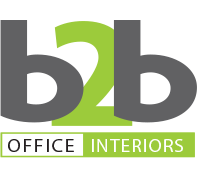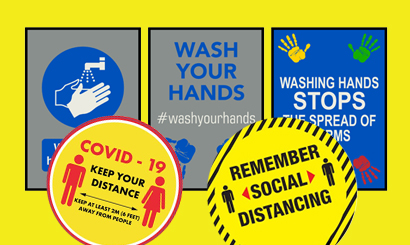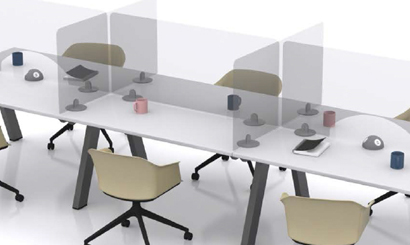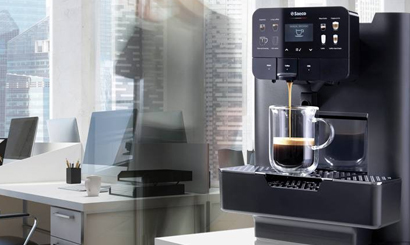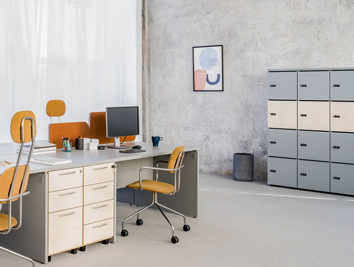The spread of the Coronavirus (COVID19) has led the world into quarantine.
In Ireland, most restrictions concerning businesses have been lifted in July, but this does not mean a full return to the same way it was before. There are many regulations regarding social distancing that should be implemented.
According to the World Health Organization, the virus is contracted through respiratory droplets or contact with a contaminated surface. When an infected person sneezes or coughs the droplets are spread in the air and then sits on nearby surfaces, once another person comes in contact with it and touches their nose, mouth or eyes they can get contaminated.
To minimise this contact and risk of contamination, new rules of social distancing have been implemented and could remain in place for the foreseeable future. We are advised to avoid physical contact, stay at least 2 meters apart from each other and wear face masks in public transport and shops.
Office Fit Out, Modern Open Plan Model and the Impact on Social Distancing
In recent decades we have seen most offices moving from cubicles and closed room to open plan and collaborative spaces. Studies being carried through many years has proved the benefits it has on team working and productivity.
On entering any modern office is common for us to see rows of desks or bench desks beside each other, designed to facilitate communication and motivate staff to look for their peers for problem-solving. Although this model is effective for teamwork it does not comply with the new regulations for social distancing.
There are strong suggestions that the cubicle is on the way back, but for the moment we are seeing businesses adapting in different ways to ensure employees safety while striving to maintain the level of interaction and productivity they had before.
Home Office and Other Alternatives
During the lockdown phase, many businesses were required to close or wherever possible staff were working from home.
Following the partial reopening, many companies have decided to maintain this model of work to avoid staff contact and contribute to maintaining a low number of people using public transport.
In some cases it is impossible to fully operate without staff in the office, there also mixed attitudes from staff, some prefer working from home while others feel less productive or do not have appropriate space or environment for it.
As a temporary solution, some employers choose to implement a schedule, alternating days for employees to be in the office. In many cases, having an empty office desk in between two occupied office desks enables 2 meters of social distancing.
The use of online platforms such as Zoom and Microsoft Teams has grown. Online platforms combined with devices like webcameras and headsets facilitate reliable communication, being a better alternative than enclosed in a meeting room. This helps to maintain staff involvement and feeling connected, minimising the impact that working from a home office could have on productivity.
Many organisations have successfully adapted these methods with their customers and clients. The online business model was already trending, now people that preferred personal contact have been persuaded to try online shopping and realised that there are some advantages to carrying out business from home.
Office Planning and Office Fit-Out to Adapt to Social Distance Restrictions
While the above solutions are helping the compliance with regulations, it is anticipated that the rules will remain in place for the foreseeable future and that some physical adaptations in the office will continue to be necessary. Some locations such as cafes, restaurants, pubs and supermarket will require even more drastic changes.
The office furniture, office supplies, material and devices below are helping maintain social distancing:
The signs indicating where people should stand in the queue, the two meters distance tape, one-way system indicators, are some of the great solutions to help people maintaining social distancing.
The office pods were increasing in popularity before the COVID19 spread became an issue. Sometimes colleagues working in an open-plan office need a place for a private conversation or to avoid the noise and focus on an important task, the office pods are the solution for it.
Since businesses have begun to adapt to returning to work, the demand has increased dramatically. As an example, Office Pods offer an isolated space for someone at greater risk of the virus when needing to visit the office.
Some organisations decided to implement the use of office pods in combination with alternating the days that each staff go to the office, which guaranteed a safe distance of 2 meters.
Whenever possible, having the windows open and the room well ventilated is preferred to any AC system, this is because these systems reuse the air in the room and most of the time the filters are not enough to prevent the spread of the virus.
Depending on the conditions, outside areas can be used as a safer space to work. Outdoor furniture can make the area pleasant and functional. The weather can play a part in this picture, but simple solutions as gazebos and outdoor heaters can help to make the area usable for a longer period during the year.
Business meetings can be taken outside, or the staff can use the tables while working from a laptop. As well as help preventing viruses it has a positive impact on the person’s mood.
The most adopted method of protection, also known as sneeze guards, COVID screens or protective screens, these screens protect the droplets to reach the surfaces on the other side and put a barrier between people, mainly when two meters apart is not possible.
Many offices are opting for the more robust office partitions, which can match the office design while offering protection and privacy. These dividers protect and improve the office’s design, while partly preserving the concept of an open-plan office, easy communication and access to work colleagues at a safe distance.
While office furniture helps maintain a safe distance in the office, many other products prevent the spread of Coronavirus, implementing alcohol gel dispenser in every room or having hand sanitizer available on the desks, offering face masks and surface cleaners.
Maintaining high standards of hygiene is the number one recommendation from health authorities and it is the responsibility of both employers and employees.
Staff Morale on Returning to Work
Employees will feel different about returning to work after quarantine, depending on how what was their situation and experiences. Some people may have been months without working while others may have worked under less than ideal conditions at home.
It is important to consider everything and create a plan to boost staff morale so productivity won’t be impacted. The plan will vary from company to company, depending on resources and business culture, but small changes can often make a great difference:
Studies show that having a coffee machine in the office has an impact on staff morale. Moreover, it can offer a properly spaced location for colleagues to safely interact, creating a healthy atmosphere within the business.
Also proven to have an impact on productivity, a well designed and harmonious space offers the right conditions for working and creating. Plants complement the environment and improve air quality.
Returning to work will require many adaptions on all sides, but if it is well planned and carried out strategically, it can be done without much disruption.
If your business needs help in this process, contact our team and they will be delighted to discuss and advise on the best solution for your business.
